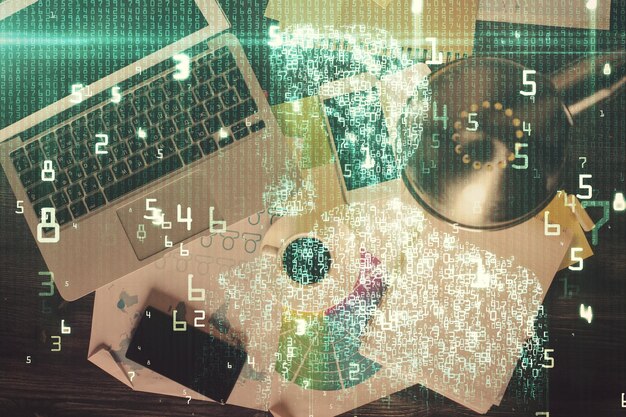NSA Joins Allies: Sharing the Best Practices for Event Logging to Enhance Cybersecurity
Recent years have seen a significant surge in cyberattacks, with organizations of all sizes and sectors falling prey to sophisticated threats. In response to this growing threat landscape, various governments and international organizations have been collaborating to share best practices and strengthen their cybersecurity posture. One such initiative is the
NSA’s (National Security Agency) involvement in sharing best practices for event logging
.
Event logging, the process of recording and analyzing system activities and events, is a crucial element in detecting, preventing, and responding to cyber threats. By keeping a record of system activities and events, organizations can identify anomalous behavior, track down the source of an attack, and improve their security posture.
In this collaborative effort, the
NSA
is sharing its expertise and experience in event logging with its allies and partners. The agency’s best practices include:
Implementing a centralized logging system to collect and store event data from all systems and applications.
Using standardized formats for event logs, such as the Common Event Log Format (CEF), to enable easier analysis and correlation of events.
Implementing automated event analysis and correlation tools, such as Security Information and Event Management (SIEM) systems, to quickly identify suspicious activity.
Establishing clear policies and procedures for handling event logs, including regular review and retention periods.
By adopting these best practices, organizations can improve their ability to detect and respond to cyber threats in a timely and effective manner. Moreover, the collaboration between various governments and international organizations in sharing best practices and expertise is an important step towards strengthening the cybersecurity posture of all parties involved.
The Importance of Event Logging in Today’s Cybersecurity Landscape
In today’s digital world, the importance of cybersecurity cannot be overstated. With the increasing reliance on technology and digital systems, organizations and governments alike face a constant threat from cybercriminals seeking to exploit vulnerabilities and gain unauthorized access to sensitive information. The consequences of such breaches can be devastating, leading to data loss, financial damage, and reputational harm. Recent high-profile cyberattacks, such as the
WannaCry Ransomware
attack in 2017 and the
SolarWinds Supply Chain Attack
in 2020, serve as stark reminders of the potential impact on organizations and governments.
Given this reality, it is essential that organizations have effective measures in place to detect and respond to cyber threats. One such measure is event logging, which involves recording all significant events or actions that occur within an information technology (IT) system or network.
Event logging
provides valuable insight into the activities of users and systems, enabling organizations to identify anomalous behavior that may indicate a cyber attack or insider threat. By analyzing event logs, security teams can quickly respond to threats and minimize the damage caused by an incident.
To help organizations improve their event logging capabilities and better defend against cyber threats, the National Security Agency (NSA) and its allies are sharing best practices and resources. Through initiatives such as the
Cybersecurity Directorate’s Mitigations Catalog
and the
Cybersecurity Information Sharing Partnership (CISP)
, the NSA is collaborating with industry partners to provide valuable guidance and tools for event logging and threat detection. By implementing these best practices, organizations can strengthen their cybersecurity posture and more effectively respond to the ever-evolving landscape of cyber threats.
In conclusion, in today’s digital world, where cybersecurity threats are a constant concern for organizations and governments, effective event logging is a crucial component of an organization’s overall cybersecurity strategy. By following best practices and collaborating with industry partners like the NSA, organizations can improve their event logging capabilities and better defend against cyber threats.
Sources:
Background
Explanation of the National Security Agency (NSA) and its role in U.S. intelligence and cybersecurity
The National Security Agency (NSA) is a U.S. government agency responsible for signals intelligence and cybersecurity. Established in 1952, the NSA’s primary mission is to protect U.S. national security by collecting, processing, and analyzing information from communications and data networks for foreign intelligence and cybersecurity purposes. The agency operates under the direction of the Director of National Intelligence (DNI) and is headquartered at Fort Meade, Maryland. The NSA plays a critical role in the United States Intelligence Community, providing vital intelligence to support national security decisions and military operations.
Discussion on the importance of international cooperation in enhancing cybersecurity
Cybersecurity threats are not limited to any one nation. Thus, international cooperation is essential in addressing the challenges posed by cybercrime, terrorism, and state-sponsored hacking. The NSA recognizes this need for collaboration and has established various partnerships to enhance cybersecurity on a global scale.
Description of existing partnerships
Two notable alliances that the NSA is involved in are the Five Eyes Alliance and NATO’s Cooperative Cyber Defense Centre of Excellence (CCDCOE). The Five Eyes Alliance is a multilateral intelligence-sharing agreement between the United States, Australia, Canada, New Zealand, and the United Kingdom. This partnership allows these countries to share intelligence on cybersecurity threats, enabling them to better defend their networks and respond to incidents more effectively.
Overview of past collaborations between the NSA and its allies on cybersecurity matters
Throughout history, the NSA has engaged in various collaborative efforts with its allies on cybersecurity matters. For instance, during the Stuxnet operation in 2010, the NSA worked with Israel to create a sophisticated cyberweapon that targeted Iran’s nuclear program. Another successful initiative includes the Eurocorps Cybersecurity Project, which was a joint training exercise between NSA personnel and military forces from France, Germany, Belgium, and Luxembourg. These collaborations demonstrate the importance of international cooperation in addressing complex cybersecurity challenges.
I Best Practices for Event Logging
Explanation of event logging and its importance in cybersecurity
Event logging is the process of recording and storing information about system activities and events as they occur.
Detailed exploration of the NSA’s best practices for event logging
Recommended collection methods:
- Centralized logging: Collecting logs from multiple systems and storing them in a single location for easier analysis
- Real-time monitoring: Monitoring logs in real-time to identify and respond to threats as they occur
Standardizing log formats: Using consistent log formats and data structures makes it easier to analyze logs across different systems and identify trends or anomalies.
Proper retention policies: Implementing proper retention policies ensures logs are available for forensic analysis when needed.
Description of additional tools and techniques provided by the NSA to facilitate event logging
Automated threat detection systems: Utilizing machine learning algorithms and advanced data analytics to identify and respond to threats automatically
Continuous monitoring solutions: Implementing continuous monitoring solutions to provide real-time visibility into system activities and potential threats
Advanced data analytics and machine learning algorithms: Leveraging these technologies to analyze large volumes of log data and identify patterns, trends, and anomalies
Explanation of how the best practices can be implemented across different sectors
The NSA’s best practices for event logging can be implemented across various sectors, including government, finance, healthcare, and critical infrastructure. By adhering to these guidelines, organizations can significantly improve their cybersecurity posture and better protect against potential threats.
International Collaboration on Event Logging Best Practices
Announcement of the NSA’s Plans to Collaborate with Its Allies on Event Logging Best Practices
The National Security Agency (NSA) recently announced its plans to collaborate with its allies on event logging best practices. This international initiative aims to enhance cybersecurity capabilities of organizations and governments worldwide. The expected benefits are numerous, including:
Improved Information Sharing
With better event logging practices in place, international organizations and governments can more effectively share threat intelligence, improving their ability to counteract advanced threats.
Enhanced Interoperability
By harmonizing event logging methods, organizations can better collaborate and integrate their systems, leading to improved interoperability and more effective joint operations.
Discussion on the Importance of Harmonizing Cybersecurity Efforts Among Allies
As advanced threats continue to evolve and become more sophisticated, it is crucial that cybersecurity efforts among allies are harmonized. The potential challenges associated with international collaboration include:
Regulatory Frameworks
Differences in regulatory frameworks and data protection laws between countries can make it difficult to share information and best practices.
Resource Constraints
Resource-constrained organizations may struggle to implement new event logging best practices due to a lack of personnel, technology, or budget.
Overview of Ongoing Collaborations Between the NSA and Its Allies on Event Logging Best Practices
Despite these challenges, ongoing collaborations between the NSA and its allies continue to make progress in this area. Some examples include:
Joint Research Initiatives
Collaborative research initiatives, such as the Cybersecurity TechSprint, bring together experts from different countries to develop and share innovative cybersecurity solutions.
Knowledge-Sharing Platforms
Platforms like the Joint Cybercrime Action Taskforce (J-CAT) provide a forum for law enforcement agencies to share information and coordinate responses to cyber threats.
Training Programs
Training programs, such as the Defense Cyber Partnership (DCP), aim to build capacity in partner countries by providing cybersecurity training and expertise.
Description of the Potential Role of Multilateral Organizations in Facilitating International Cooperation on Event Logging Best Practices
Multilateral organizations, such as the United Nations (UN) and the European Union (EU), can play a crucial role in facilitating international cooperation on event logging best practices. By providing a neutral forum for dialogue, these organizations can help overcome regulatory and political obstacles, ultimately leading to more effective cybersecurity collaboration among nations.
Conclusion
As we delve deeper into the digital age, the importance of cybersecurity,
Role of NSA and Allies in Best Practices for Event Logging
The National Security Agency (NSA) and its allies have been at the forefront of setting these best practices for event logging. With their wealth of experience, expertise, and resources in cybersecurity, they provide invaluable insights that can guide us in enhancing our security posture. Their initiatives not only help strengthen the defenses of their own networks but also set standards for others to follow.
Call to Action
It is now imperative that governments, organizations, and individuals take heed of these best practices. Adopting them will not only help fortify your cybersecurity defenses against current threats but also prepare you for future challenges. The time and resources invested in implementing these practices will be well worth it.
Continued International Cooperation
International cooperation
(emphasize), particularly on cybersecurity matters, is essential to building a more secure digital future for all. By working together, we can share knowledge, resources, and expertise to better understand and address the global cybersecurity landscape. This collaboration not only strengthens our individual security postures but also fosters a collective resilience against cyber threats.
Towards a Safer, More Secure Digital Future
In conclusion, the importance of cybersecurity, event logging, and international collaboration cannot be overemphasized in today’s digital landscape. By adhering to best practices, embracing continuous improvement, and working together, we can create a safer and more secure cyber world for present and future generations.






